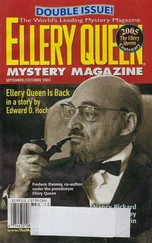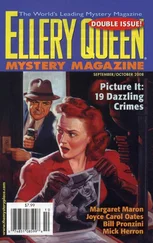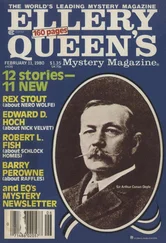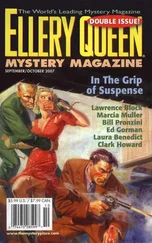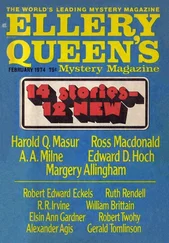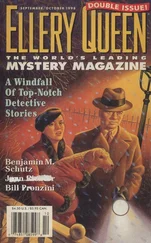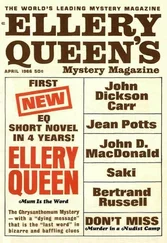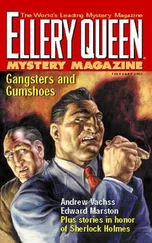Robert Barnard - Ellery Queen’s Mystery Magazine. Vol. 135, No. 2. Whole No. 822, February 2010
Здесь есть возможность читать онлайн «Robert Barnard - Ellery Queen’s Mystery Magazine. Vol. 135, No. 2. Whole No. 822, February 2010» весь текст электронной книги совершенно бесплатно (целиком полную версию без сокращений). В некоторых случаях можно слушать аудио, скачать через торрент в формате fb2 и присутствует краткое содержание. Город: New York, Год выпуска: 2010, Издательство: Dell Magazines, Жанр: Детектив, на английском языке. Описание произведения, (предисловие) а так же отзывы посетителей доступны на портале библиотеки ЛибКат.
- Название:Ellery Queen’s Mystery Magazine. Vol. 135, No. 2. Whole No. 822, February 2010
- Автор:
- Издательство:Dell Magazines
- Жанр:
- Год:2010
- Город:New York
- ISBN:нет данных
- Рейтинг книги:3 / 5. Голосов: 1
-
Избранное:Добавить в избранное
- Отзывы:
-
Ваша оценка:
- 60
- 1
- 2
- 3
- 4
- 5
Ellery Queen’s Mystery Magazine. Vol. 135, No. 2. Whole No. 822, February 2010: краткое содержание, описание и аннотация
Предлагаем к чтению аннотацию, описание, краткое содержание или предисловие (зависит от того, что написал сам автор книги «Ellery Queen’s Mystery Magazine. Vol. 135, No. 2. Whole No. 822, February 2010»). Если вы не нашли необходимую информацию о книге — напишите в комментариях, мы постараемся отыскать её.
Ellery Queen’s Mystery Magazine. Vol. 135, No. 2. Whole No. 822, February 2010 — читать онлайн бесплатно полную книгу (весь текст) целиком
Ниже представлен текст книги, разбитый по страницам. Система сохранения места последней прочитанной страницы, позволяет с удобством читать онлайн бесплатно книгу «Ellery Queen’s Mystery Magazine. Vol. 135, No. 2. Whole No. 822, February 2010», без необходимости каждый раз заново искать на чём Вы остановились. Поставьте закладку, и сможете в любой момент перейти на страницу, на которой закончили чтение.
Интервал:
Закладка:
When Nick finished telling Sergeant Forrest his version of the story, she folded her hands tightly in front of her, looking sceptical.
“And you think your father actually committed the crime?”
“I don’t think, I know,” Nick said tersely.
He handed her a CD he’d burned that morning. She glanced at it curiously and slipped it into her computer. He studied her eyes, which became more troubled as she watched it.
Afterward, she said, “It’s obviously important evidence. It must have been a terrible thing to witness, for someone so young.”
He wasn’t interested in her pity, just her assistance. He mentioned his parents’ marriage, which had slowly deteriorated because of his father’s drinking and volatile temper. He identified the crumpled necktie on the bed as one he’d given Dom on Father’s Day.
“It’s pretty obvious this guy Blake was framed,” Nick said. “That he was chosen to take the fall for Mom’s murder.”
“We don’t know that,” Sergeant Forrest said carefully. “That’s what investigations are for, to get at the truth.”
Nick clenched his teeth. “The camera never lies.”
He let the words hang there between them, his eyes unblinking. She didn’t look away but she didn’t seem too comfortable, either.
Finally, she asked, “Why are you showing me this video now, after waiting so long?”
“Because my son Tony is about to turn thirteen, the same age I was when—” Nick broke off, swallowing with difficulty. “I don’t want him to grow up with a bunch of secrets between us. I lost my mother. I don’t want to lose him too.”
“It could get very ugly, Nick. You need to understand that.”
“I understand that my mother deserves justice.”
“And what about you? How are you holding up, keeping all this to yourself all these years?”
He dropped his eyes. “I’ve had a few problems.”
“You’re hoping for some resolution.”
“You could say that.”
“I’ll look into it. But I’d prefer to go about it quietly, without a formal complaint. It might make my initial inquiries easier.”
He raised his conflicted eyes. “I picked you because I trust you.”
“I appreciate that,” she said.
Her first step after talking with Nick was to fill out a standard request form for the Rosemary Falco report, which she delivered personally to the Homicide Library, keeping her supervisor out of the loop. She knew it was risky but felt it was necessary at this stage. To her surprise, the clerk reported that the file was missing. Probably misfiled, he said, and promised to begin a search. But two days later, he e-mailed her that the file was nowhere to be found, and there was no record of it being checked out. This caused her some concern.
She considered going to her commander, then thought better of it. Not yet. Not until she had enough evidence so that no one above her could quash an investigation. Then she remembered that two decades back, before the department was fully computerized, a hard copy of every homicide incident report was sent to the Records Bureau. If someone had deliberately hidden or destroyed the original report, it was possible they’d forgotten about a copy being kept in Records.
This time, at the Reports Retrieval Unit, she struck pay dirt. She surreptitiously made a photocopy of the report, which she read during a solitary lunch in Chinatown, miles from headquarters.
The report placed Rosemary Falco in her kitchen when she died, fully dressed, the victim of an intruder. That version had been corroborated by crime-scene photos and a coroner’s investigation. With Marshall Blake’s alleged confession and jailhouse suicide, the homicide case had fallen into inactive status, effectively if not officially closed. Sergeant Forrest knew that Dominic Falco, only a deputy, couldn’t have carried out such an elaborate coverup on his own, that he must have had help within the department.
She felt sick about what she’d uncovered, about the wider implications. But as she reached the bottom of the final page, she was in for one more shock.
The report had been signed by the lead investigator on the case: George Claxton.
She drove directly from Chinatown to the storage section of the crime lab. She was relieved to learn that the key physical evidence in the case had been properly preserved and ordered samples taken from the victim’s clothing and fingernails. That done, she tracked down Marshall Blake’s widow, who still lived in the same house, and asked a few discreetly worded questions. She discovered that Mrs. Blake had tossed her husband’s personal items into a box and stashed them in the garage, intending to sort through them before disposal. In her pain and confusion, Mrs. Blake had procrastinated, and the box had remained there ever since, untouched. Among the items was a brush and comb set that Sergeant Forrest bagged and submitted for DNA analysis — unavailable twenty-two years ago. At the crime lab, she cashed in a favor to get the DNA processed quickly and on the QT.
With that underway, she drove east two hours to Palm Desert to visit Bud Billingsley, a retired deputy she’d met when they were rookies at the training academy. Billingsley, whose problem with black people had surfaced when he’d worked patrol, had been assigned desk duty at county jail around the time Rosemary Falco had been killed. She figured Billingsley might know something and be willing to give it up, for reasons having to do with his ingrained racism.
A longtime divorcé, he lived alone in a middle-class neighborhood down the highway from Palm Springs. Heat shimmered off the asphalt as she turned into his cul-de-sac and pulled up in front of his two-bedroom house. She found him lounging by a small pool with two little dogs, a pot-bellied man with leathery skin, drinking beer before noon. When she explained what she was after, he was quiet a moment, then told her that everything he was about to say was strictly background, off the record.
“I don’t need no trouble,” he said. “I’m too damn old. You okay with that?”
She told him she was. He started talking.
After being processed into the old Hall of Justice jail, Billingsley said, the suspect, Marshall Blake, was left alone in his cell with bed sheets on the bunk, despite signs of serious despondency that might have called for a suicide watch. A short time later, he was found dead, hanging by his neck from a knotted sheet.
“Was George Claxton around that night?” Sergeant Forrest asked.
“Claxton,” Billingsley asked, contemptuously, “the colored guy that got rich producing Police in Action? Yeah, he was around — and he made sure things went down the way they did.”
The other deputies were more than happy to cooperate, Billingsley added, eliminating a suspect who’d killed a deputy’s wife.
“What if Blake was innocent, Bud? What if someone else did it?”
“Then why would he do the hangman’s dance like he did?”
“Maybe he was grief-stricken because a woman he cared about was dead, while he got blamed for her murder.”
“I guess you could see it that way,” Billingsley said. “Anyway, I’ve told you what I know. Off the record, remember.” He raised his beer bottle. “You want a cold one?”
She declined, thanked him for the information, and showed herself out.
After four days, Nick Falco was back at Claxton Productions, unable to stay away from work.
He dropped by the digital editing bays to watch segments being cut, viewed assembled episodes to see how many of his stories had made it into the show, ran a maintenance check on his camera pack — anything to stay close to the action and keep his mind off the investigation Katherine Forrest was conducting behind the scenes.
Читать дальшеИнтервал:
Закладка:
Похожие книги на «Ellery Queen’s Mystery Magazine. Vol. 135, No. 2. Whole No. 822, February 2010»
Представляем Вашему вниманию похожие книги на «Ellery Queen’s Mystery Magazine. Vol. 135, No. 2. Whole No. 822, February 2010» списком для выбора. Мы отобрали схожую по названию и смыслу литературу в надежде предоставить читателям больше вариантов отыскать новые, интересные, ещё непрочитанные произведения.
Обсуждение, отзывы о книге «Ellery Queen’s Mystery Magazine. Vol. 135, No. 2. Whole No. 822, February 2010» и просто собственные мнения читателей. Оставьте ваши комментарии, напишите, что Вы думаете о произведении, его смысле или главных героях. Укажите что конкретно понравилось, а что нет, и почему Вы так считаете.

